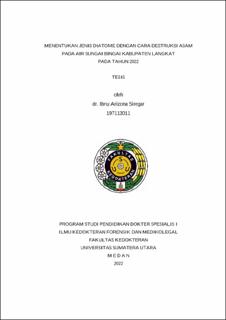Menentukan Jenis Diatome dengan Cara Destruksi Asam pada Air Sungai Bingai Kabupaten Langkat pada Tahun 2022

Date
2022Author
Siregar, Ibnu Arizona
Advisor(s)
Petrus, Asan
Parinduri, Abdul Gafar
Metadata
Show full item recordAbstract
Background: Victims of drowning are almost always found from time to time. This
is not surprising because all around us there are sewers, wells, ponds, rivers, lakes
or seas, even buckets filled with water or bathroom tubs. Floods are not something
that rarely happens, we have just faced the death toll from drowning in the hundreds
of thousands of people due to the tsunami waves. Examination of victims who are
lifted from the water outside the flood or disaster season, is a death that is doubtful
as a homicide event. It is very important to determine whether the victim was still
alive when he entered the water or if he had died before drowning.
Diatoms as diagnostic aids to investigate drowning cases need to be
examined to find out the location of the place where the body sank before death, by
comparing the diatoms contained in the victim's body with the water diatoms where
the body was found or suspected to be the place where the body drowned.
This type of research was carried out descriptively, namely to determine
the type of diatoms in the Bingai river in Langkat Regency in helping to determine
the crime scene of drowning victims. This research was conducted in the Bingai
river. The research population is diatoms in the Bingai river in Langkat Regency.
The material used in this research is the river water.
Methods: this research is descriptive, namely to determine the type of diatoms in
the Bingai river in 2022 by taking samples of river water in the Upper, Middle and
Lower parts, then treated with acid destruction, then centrifuged and then viewed
under a microscope.
Result: Obtain various types of diatoms which are reported in the form of picture
tables and tabulation of diatom profiles based on the shapes found in each station.
Conclusion: various types of diatoms and forms of diatoms were obtained at each
station.
Collections
- Master Theses [44]
